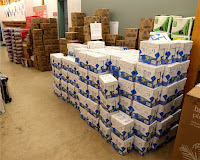Arctic Bay’s annual sealift season began on August 30 with the arrival of the Rosaire A Desgagnes vessel, operated by NSSI. The vessel is large at a length of 138.06 metres. Thankfully, the depth of the bay is deep enough for large cargo vessels to anchor close to shore, shortening the transportation time of the small tugboats & barges.
For those of you reading this blog for the first time, Nunavut communities are only accessible by air & sea during the summer months. There is no permanent highway network in the territory and no roads to southern Canada. I use the word permanent because ice roads are used in some places, but these are not extensive and restricted to winter. Speaking of winter, when the waterways freeze & turn to ice, the only fast way to transport supplies in large quantities is by plane.
The short summer months enable large cargo vessels to travel & deliver large amounts of supplies to communities. Since this occurs only once a year, people & businesses order items in bulk, holding them over until the next sealift. Heavy items that are too large to fit on planes are also ordered. Think vehicles, furniture, boats, prefab houses, water, and anything else that’s not prohibited. It can be costly to ship by sea, but I think you save money in the long run. Air cargo transportation is still “the most expensive mode of shipping.”
I headed down to the shoreline in front of the Northern Store to take a closer look at what was being offloaded. At that time, the shoreline crew had only offloaded several sea containers, loaders, and a few wooden crates. Luck was on my side because one of those wooden crates was mine. Thanks! Now I had to hire a local mover to deliver the crate to my residence. More containers, crates, and several vehicles were brought ashore the following day (August 31). People are advised to avoid the unloading area due to heavy loaders and the fast pace of work. Cargo ships can’t stay in town too long because they have other communities to visit and the sailing schedule regularly changes due to weather and other setbacks.
I was able to hire a local mover, and they delivered my wooden crate. I opened the crate on September 1st with the assistance of a crowbar, hammer, and axe. Two locals helped me move my belonging inside. I spent the next 2 – 3 hours unpacking, sorting, and putting everything away. My residence now looks like a fully stocked bomb shelter. Not all the items are for home. Several of them are for school and cadets. The pieces of wood that made up the wooden crate were picked up and taken to the landfill.
The Rosaire A Desgagnes departed after a three-day stay. The next vessel to arrive was the Aujaq, operated by NEAS, on September 5. The Aujaq is another large cargo vessel but just a metre shorter in length compared to the Rosaire. The unloading & delivery process was the same as before. Sea containers, wooden crates, and loaders occupied the shoreline in front of the Northern Store. Inuujaq School’s sealift orders happened to be on this vessel, and I located the tall, heavy wooden crates after school. I notified the principal of their arrival. The school supplies we normally order are photocopying paper, arts & crafts, food for the breakfast program, stationary, furniture, sports equipment, filing cabinets, and custodial supplies.
The crates were moved to Inuujaq School the following day (September 6) and then opened on September 7. School staff mostly did the unpacking and moving items inside the school. I think several high school students helped as well. I wasn’t available because I was cleaning the shoreline behind the airport with the army cadets. (More on this in a future post). I was told it took an hour or two to empty all the wooden crates and bring the items inside. The school’s main hallway looked like a warehouse by the end of the day. The large wooden crates were made available to anyone in the community for free. People use them for storage and/or building materials.
It’s going to take several days for school administration to record what items arrived & didn’t, unpack everything, determine where items go, deliver those items, and then dispose the leftover packaging. It’s a good thing I keep accurate records.
The
Aujaq departed after three days.
I should also mention a tourist ship, operated by Quark Expeditions, spent a couple of hours in the community on September 6. It’s been a while since a cruise ship visited the community. I guess the COVID-19 pandemic is truly over. Tourists were ferried to shore & back using Zodiac boats. The drivers avoided the sealift operation by driving into the breakwater pier. Tourists were given a few hours to walk around town and take pictures. It’s easy to spot the tourists because they wear large yellow jackets.

















No comments:
Post a Comment